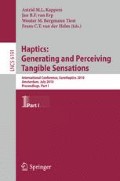Abstract
This paper describes a novel approach to authenticate entry to a system using tactile feedback. The user is required to remember a sequence of pre-selected pin patterns. A study has been undertaken to determine the feasibility of the tactile authentication mechanism, through a comparison with a graphical scheme. Findings from a within-subjects study have revealed that both tactile and graphical authentication sequences could be entered at specific points over the course of a five month period. While graphical sequences could be entered on average 28.5 seconds faster than tactile sequences, participants believed the tactile mechanism offered greater levels of security from observers. As pins are presented underneath the fingertips, they are concealed from the view of third parties. As tactile sensations are difficult to describe, it is less likely that they will be disclosed to others, thereby reducing the chances of unauthorized access.
Access this chapter
Tax calculation will be finalised at checkout
Purchases are for personal use only
Preview
Unable to display preview. Download preview PDF.
References
Brewster, S.A.: Chapter 30: The impact of haptic ’touching’ technology on cultural applications. In: Digital Applications for Cultural Heritage Institutions, pp. 273–284. Ashgate Press, UK (2005)
De Luca, A., von Zezchwitz, E., Hußman, H.: VibraPass-Secure Authentication Based on Lies. In: Proceedings of ACM SIGCHI 2009, pp. 913–916 (2009)
Deyle, T., Roth, V.: Accessible Authentication via Tactile PIN Entry. Computer Graphics Topics 2, 24–26 (2006)
Orozco Trujillo, M., Shakra, I., El Saddik, A.: Haptic: The New Biometric-Embedded Media to Recognizing and Quantifying Human Patterns. In: Proceedings of the 13th Annual ACM International Conference on Multimedia (2005)
Kuber, R., Yu, W.: Tactile Authentication. Patent No 0603581.0 (Patent Applied For) (2006)
PassfacesTM Demonstration Software, Passfaces Corporation (2009), http://www.passfaces.com
Brostoff, S., Sasse, M.A.: Are PassfacesTM more usable than passwords? A field trial investigation. In: Proceedings of HCI 2000, pp. 405–424 (2000)
Valentine, T.: An Evaluation of the Passface Personal Authentication System (Technical Report), London, UK (1998)
Valentine, T.: Memory for PassfacesTM after a Long Delay (Technical Report), London, UK (1999)
Kuber, R., Yu, W.: Feasibility Study of Tactile-based Authentication. International Journal of Human Computer Studies 68, 158–181 (2010)
Author information
Authors and Affiliations
Editor information
Editors and Affiliations
Rights and permissions
Copyright information
© 2010 Springer-Verlag Berlin Heidelberg
About this paper
Cite this paper
Kuber, R., Yu, W. (2010). Tactile vs Graphical Authentication. In: Kappers, A.M.L., van Erp, J.B.F., Bergmann Tiest, W.M., van der Helm, F.C.T. (eds) Haptics: Generating and Perceiving Tangible Sensations. EuroHaptics 2010. Lecture Notes in Computer Science, vol 6191. Springer, Berlin, Heidelberg. https://doi.org/10.1007/978-3-642-14064-8_45
Download citation
DOI: https://doi.org/10.1007/978-3-642-14064-8_45
Publisher Name: Springer, Berlin, Heidelberg
Print ISBN: 978-3-642-14063-1
Online ISBN: 978-3-642-14064-8
eBook Packages: Computer ScienceComputer Science (R0)

